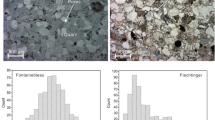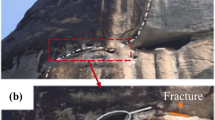Abstract
The evolution of geometry and flow characteristics under stress is of great significance for many natural and technological processes. In this paper, a three-dimensional rough single fracture model is reconstructed based on three-dimensional morphology scanning technology. The geometric deformation and flow characteristics of natural fracture inside tight sandstone under varied shear displacements and loads are simulated using the finite element method. The results show that the primary factors causing variations in flow characteristics are geometrical deformations under stress such as reduced apertures, expanded contact areas, and degradation of roughness. With the increasing stress, the aperture and contact area of the fracture would experience an evident decrease and increase, respectively, leading to an increase in the flow resistance. Simultaneously, the degradation of roughness would exacerbate these changes in the aperture and contact area. For the rougher fracture, the permeability and flow area can be maintained higher value due to its smaller geometric deformation and a more uniform stress distribution. Furthermore, shear displacement modifies the mismatch between the top and lower fracture surfaces, resulting in a decrease in flow rate and permeability.















Similar content being viewed by others
References
Baghbanan, A., Jing, L.: Stress effects on permeability in a fractured rock mass with correlated fracture length and aperture. Int. J. Rock Mech. Min. Sci. 45, 1320–1334 (2008)
Barton, N.: Review of a new shear-strength criterion for rock joints. Eng. Geol. 7, 287–332 (1973)
Chen, Y.-F., Zeng, J., Shi, H., et al.: Variation in hydraulic conductivity of fractured rocks at a dam foundation during operation. J. Rock. Mech. Geotech. Eng. 13, 351–367 (2021)
Chen, Z., Narayan, S., Yang, Z., Rahman, S.: An experimental investigation of hydraulic behaviour of fractures and joints in granitic rock. Int. J. Rock Mech. Min. Sci. 37, 1061–1071 (2000)
Faez, M., Ramezanzadeh, A., Ghavami-Riabi, R., Tokhmechi, B.: The evaluation of the effect of fracture geometry on permeability based on laboratory study and numerical modelling. Rudarsko-geološko-naftni zbornik 36, 155–164 (2021)
Gan, L., Shen, Z., Xiao, M.: Experimental investigation of seepage characteristics in porous rocks with a single fracture. Hydrogeol. J. 28, 2933–2946 (2020)
Gao, H., Zhang, D., Lu, J., Yin, G., Wu, M.: Experimental study on influence of intermediate principal stress on the permeability of sandstone. Transp. Porous Media 135, 753–778 (2020)
Theodor, G.V.: Developments in petroleum science. Vol. 12. Fundamentals of Fractured Reservoir Engineering.vii-ix (1982)
Huang, N., Liu, R., Jiang, Y.: Numerical study of the geometrical and hydraulic characteristics of 3D self-affine rough fractures during shear. J Nat Gas Sci Eng 45, 127–142 (2017)
Jackson, R.L., Green, I.: A statistical model of elasto-plastic asperity contact between rough surfaces. Tribol. Int. 39, 906–914 (2006)
Jang, H.-S., Kang, S.-S., Jang, B.-A.: Determination of joint roughness coefficients using roughness parameters. Rock Mech. Rock Eng. 47, 2061–2073 (2014)
Jia, Y., Song, C., Liu, R.: The frictional restrengthening and permeability evolution of slipping shale fractures during seismic cycles. Rock Mech. Rock Eng. 55, 1791–1805 (2022)
Kim, J.-Y., Kang, S.-K., Lee, J.-J., Jang, J.-i, Lee, Y.-H., Kwon, D.: Influence of surface-roughness on indentation size effect. Acta Mater. 55, 3555–3562 (2007)
Kou, M.-M., Liu, X.-R., Wang, Z.-Q., Tang, S.-D.: Laboratory investigations on failure, energy and permeability evolution of fissured rock-like materials under seepage pressures. Eng. Fract. Mech., 247 (2021)
Kulatilake, P.H.S.W., Park, J., Su, X.-P.: Fluid flow through natural single-rock fractures: experimental and numerical investigations. Int. J. Geomech., 20 (2020)
Li, K., Yu, T., Bui, T.Q.: Adaptive extended isogeometric upper-bound limit analysis of cracked structures. Eng Fract Mech 235 (2020)
Li, T., Zhang, Q., Yin, Q., Dai, W., Gu, J.: Experimental study on the nonlinear flow characteristics of fractured granite after high-temperature cycling. Geomech. Geophys. Geo Energy Geo Resour, 9 (2023)
Lu, C., Luo, Y., Guo, J., et al.: Numerical investigation of unpropped fracture closure process in shale based on 3D simulation of fracture surface. J Petrol Sci Eng, 208 (2022)
Meng, T., Li, E., Xue, Y., Ma, J., Liu, W., Xufeng, L.: Experimental study on permeability and porosity evolution of host rock with varying damage degrees in excavation damaged area under real-time ultra-high temperature and triaxial stress/seepage pressure condition. Bull. Eng. Geol. Environ. 80, 8075–8097 (2021)
Ogilvie, S.R., Isakov, E., Glover, P.W.J.: Fluid flow through rough fractures in rocks. II: a new matching model for rough rock fractures. Earth Planet. Sci. Lett. 241, 454–465 (2006)
Serrin, J.: On the stability of viscous fluid motions. Arch. Ration. Mech. Anal. 3, 1–13 (1959)
Shi, J.-Q., Durucan, S.: Modelling laboratory horizontal stress and coal permeability data using S&D permeability model. Int. J. Coal Geol. 131, 172–176 (2014)
Tzelepis, V., Moutsopoulos, K.N., Papaspyros, J.N.E., Tsihrintzis, V.A.: Experimental investigation of flow behavior in smooth and rough artificial fractures. J. Hydrol. 521, 108–118 (2015)
Wang, D.-k, Wei, J.-p, Fu, Q.-c, Liu, Y., Xia, Y.-l: Seepage law and permeability calculation of coal gas based on Klinkenberg effect. J. Cent. South. Univ. 22, 1973–1978 (2015)
Wang, K., Ma, Q., Xu, J., et al.: Determining the elastic–plastic properties of materials with residual stress included using nanoindentation experiments and dimensionless functions. Eng. Fract. Mech., 282 (2023)
Warpinski, N., Branagan, P., Engler, B., Wilmer, R., Wolhart, S. Evaluation of a downhole tiltmeter array for monitoring hydraulic fractures. Int. J. Rock. Mech. Min. Sci. 34, 311–318 (1997)
Witherspoon, P.A.: Flow of groundwater in fractured rocks. Bull.Int. Assoc. Eng. Geol. 34, 103–115 (1986)
Xu, C., Lin, C., Kang, Y., You, L.: An experimental study on porosity and permeability stress-sensitive behavior of sandstone under hydrostatic compression: characteristics, mechanisms and controlling factors. Rock Mech. Rock Eng. 51, 2321–2338 (2018)
Xue, K., Liu, X., Yan, X., Chi, X., Teng, B.: The effect of fracture surface roughness and mechanical aperture on the onset of nonlinear flow behaviors in 3D self-affine rough fractures. Geofluids 2022, 1–14 (2022)
Yang, J., Wang, Z., Qiao, L., Li, W., Liu, J.: Effects of roughness and aperture on mesoscopic and macroscopic flow characteristics in rock fractures. Environ Earth Sci, 82 (2023)
Yang, T., Wang, P., Wang, S., Liu, H., Zhang, Z.: Experimental study on shear-seepage coupling characteristics of single fractured rock mass under cyclic loading and unloading. Rock Mech. Rock Eng. 56, 2137–2156 (2022)
Yang, T., Wang, S., Wang, P., Zhang, Z.: Hydraulic and mechanical coupling analysis of rough fracture network under normal stress and shear stress. KSCE J. Civ. Eng. 26, 650–660 (2021)
Yu, J., Xu, W., Jia, C., Wang, R., Wang, H.: Experimental measurement of permeability evolution in sandstone during hydrostatic compaction and triaxial deformation. Bull. Eng. Geol. Environ. 78, 5269–5280 (2018)
Zhang A, Yang J, Cheng L, Ma C: A simulation study on stress-seepage characteristics of 3D rough single fracture based on fluid-structure interaction. J. Petrol. Sci. Eng. 211 (2022)
Zhang, Q., Luo, S., Ma, H., Wang, X., Qian, J.: Simulation on the water flow affected by the shape and density of roughness elements in a single rough fracture. J. Hydrol. 573, 456–468 (2019)
Zhao, Y., Wang, C.L., Bi, J.: Analysis of fractured rock permeability evolution under unloading conditions by the model of elastoplastic contact between rough surfaces. Rock Mech. Rock Eng. 53, 5795–5808 (2020)
Zhou, Y., Yang, D., Zhang, X., Chen, W., Xia, X.: Numerical investigation of the interaction between hydraulic fractures and natural fractures in porous media based on an enriched FEM. Eng. Fract. Mech., 235 (2020)
Zhou, Z., Zhang, J., Cai, X., et al.: Permeability evolution of fractured rock subjected to cyclic axial load conditions. Geofluids 2020, 1–12 (2020)
Acknowledgements
This study is financially supported by Basic Research on Coalbed Methane and Coalbed Methane Combined Recovery (U19B2009), and Coupling Evolution Law of Fracturing and Mining Fissure in Hard Top Plate and the Control Mechanism of Mining Pressure (51974042). The financial support is gratefully acknowledged.
Author information
Authors and Affiliations
Contributions
B.X.: Conceptualization, Writing - review & editing, Supervision, Project administration, Funding acquisition. J. H.: Methodology, Software, Investigation, Writing - original draft, Software, Validation, Formal analysis. J.P.: Methodology, Software, Investigation, Writing - review & editing. Y. Z.: Methodology, Investigation, Software.
Corresponding author
Ethics declarations
Competing interests
The authors declare no competing interests.
Additional information
Publisher's Note
Springer Nature remains neutral with regard to jurisdictional claims in published maps and institutional affiliations.
Rights and permissions
Springer Nature or its licensor (e.g. a society or other partner) holds exclusive rights to this article under a publishing agreement with the author(s) or other rightsholder(s); author self-archiving of the accepted manuscript version of this article is solely governed by the terms of such publishing agreement and applicable law.
About this article
Cite this article
Xia, B., Huang, J., Peng, J. et al. The evolution of geometry and flow characteristics of fracture inside tight sandstone under stress. Arch Appl Mech 94, 903–919 (2024). https://doi.org/10.1007/s00419-024-02555-z
Received:
Accepted:
Published:
Issue Date:
DOI: https://doi.org/10.1007/s00419-024-02555-z




